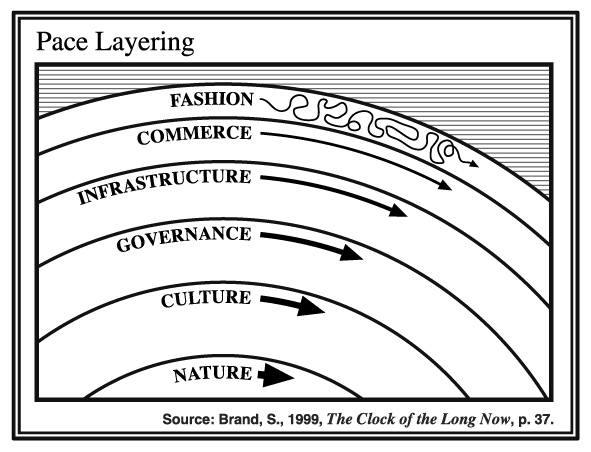Pace layers and how they apply to design
Understanding pace layers is crucial for designers aiming to create products that endure and evolve.
Pace layering is a concept developed by Stewart Brand in his book “The Clock of the Long Now”. The idea is that in a complex system (like society, an ecosystem, or a business context), different layers move at different paces, from fast to slow.

Brand identified six layers: fashion/art, commerce, infrastructure, governance, culture, and nature, each moving slower than the previous one. The slower layers help maintain stability, while the faster layers promote innovation.
Applying the concept of pace layers to design, particularly within service or product design, can help create solutions that are both innovative and stable.
Here’s how each pace layer could potentially apply to design:
Fashion/Art (Fast)Permalink to section titled Fashion/Art (Fast)
This is the layer of design that is most subject to change and trends. It’s about experimentation and what’s visually or functionally “in”. In design, this could be about the latest UI trends, colour schemes, or material finishes. It’s highly dynamic and changes from season to season.
Commerce (Fast, but slower than fashion)Permalink to section titled Commerce (Fast, but slower than fashion)
This layer is about transactional relationships and the commercialisation of design elements. It’s less volatile than fashion but still needs to be responsive to market demands. In design, this might concern the business models, monetisation strategies, or marketing tactics.
Infrastructure (Moderate)Permalink to section titled Infrastructure (Moderate)
In design, infrastructure refers to the underlying frameworks and standards that support creating products and services. This could be the code libraries in software design, manufacturing processes in industrial design, or service delivery systems in service design. This layer changes more slowly, requiring more significant investment and coordination to evolve.
Governance (Slow)Permalink to section titled Governance (Slow)
Here, we look at the rules, regulations, and standards that govern the design process and output. This includes design principles, ethical guidelines, industry standards, and best practices. Changes at this layer are infrequent and often the result of broad consensus or regulatory shifts.
Culture (Slower)Permalink to section titled Culture (Slower)
Cultural values and user behaviours are deeply embedded and change slowly over time. They heavily influence design priorities and user experience. Design at this level must consider long-term societal trends, cultural heritage, and deeply held user beliefs.
Nature (Slowest)Permalink to section titled Nature (Slowest)
In the design context, we can think of this as the physical and psychological realities of human interaction with products and services. This layer changes only over centuries or millennia; for example, our physiological response to colour or our innate need for social interaction. Good design at this layer is empathetic to human nature and creates products that are ergonomic, intuitive, and sustainable.
Understanding and applying pace layers to design can lead to more resilient and adaptive products and services. Designers can innovate quickly at the fashion/art layer while relying on the stability and longevity of the slower layers to ensure their designs stand the test of time and contribute positively to the human experience.